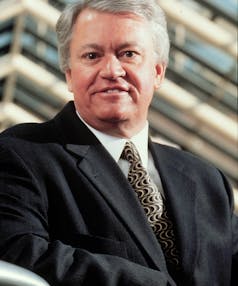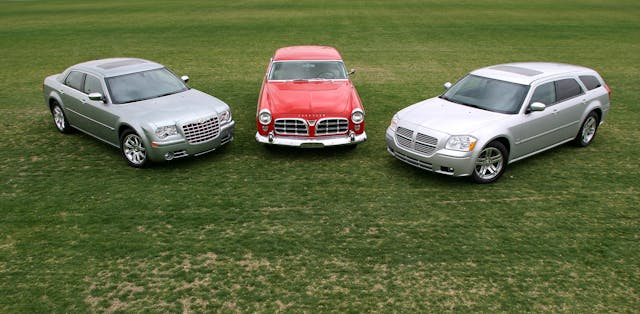Bringing up the rear: The birth of Chrysler’s rear-wheel-drive LX cars
Fiat-Chrysler’s rear-wheel-drive LX cars—the Dodge Charger, Challenger, and Chrysler 300—remain a fixture at the company, particularly at Dodge, even as mainstream rear-drivers become an anomaly in the industry. Their continued popularity begs the question: How did the LX cars arrive in the first place?
Chrysler abandoned rear-wheel drive in 1989 with the demise of the Plymouth Gran Fury, Dodge Diplomat, and Chrysler Fifth Avenue. In 1993, the company replaced its long-in-the-tooth K-car derivatives with a new family based on the front-wheel-drive LH platform, a switch that yielded the Chrysler Concorde, LHS, New Yorker, and 300M, Dodge Intrepid, and the Eagle Vision. Long and low, these cars’ “Cab Forward” designs accentuated their front-wheel-drive mechanicals; the packaging was refreshingly modern, and a welcome relief after more than a decade of slab-sided K-cars. After two LH generations, however, the 1998 Daimler-Benz and Chrysler merger halted further development of the platform.
Tom Gale, Chrysler’s former VP of design, saw an opportunity to switch to rear-wheel drive as a competitive advantage.

“I just felt like we needed it to shade those segments and have a meaningful differentiation from our competitors,” Gale says. “It really gave the consumer a reason to consider a brand of a company that was smaller.”
Even so, Gale had to fight hard to get the LX platform approved. At the time, he was on the board of directors, and was responsible for product engineering as well as design. It quickly became obvious that company engineers simply wanted another front-wheel-drive platform.
“That’s what the engineers wanted to do, because it’s easier,” Gale remembers. “And I said, ‘What’s your reasoning for not wanting to do it?’ ‘Well, you know, they’re heavier.’ I said, ‘Well, get out all of the parts and we’ll weigh them up.’ Then they said, ‘Well, they’re more costly.’ So we built the cars both ways, and I got all the parts going one way and going the other way. And OK, there was like a couple hundred dollars more in the rear-wheel-drive platform at the time.
“But then I went out and did unbranded research on what the consumers’ impression of the value or the cost of the [rear-wheel-drive] vehicle was. It always $5000–6000 more, the anticipated purchase price. Well, that was the clincher.”
The LX platform was derived from the LH, with front suspension built in-house and the rear setup sourced from the Mercedes-Benz E-Class. (Mercedes also provided the five-speed automatic transmission.) “I even made the car taller because I felt it enabled us to package it in a shorter and different look; it was a new proportion,” Gale says.
“We had access to a platform that was somewhat [like] the E-Class Mercedes,” says Tim Kuniskis, head of passenger cars for FCA’s North American division. “If you think about what the platform was, and what Mustang was, there was no way these could be the same cars. The E-Class is significantly bigger—way different proportions, rode higher, sat higher, bigger, and heavier. So some of that drives your thinking.”
Initially, the LX cars consisted of the 2005 Chrysler 300 and Dodge Charger sedans, alongside the Dodge Magnum station wagon, with the Challenger coupe arriving once the Magnum departed in 2008.

“If you think about how we launched the Challenger, we launched it first as an SRT-only with a 6.1-liter, and 425 horsepower, which is insane. We’re going top-of-the-line only, super expensive, the highest horsepower thing out there. If you think about it, we haven’t deviated that much from that formula.”
Indeed.
Chrysler continued to increase horsepower output in the the LX cars and hasn’t flagged since. Still, the cars we have in 2021 could have been very different.
In 2013, internal debates raged concerning whether to simply do a mid-cycle refresh of the existing cars or to create an all-new car since Chrysler, after its merger with Italian automaker Fiat, had access to the Giorgio platform. Chrysler executives considered how customers actually used their cars: They found that buyers identified with drag racing, not road racing, even though many would never take their cars on a circuit.
“But you know what? They have been at a stoplight, and they have raced the guy next to them.” Kuniskis says. “And they did that when they were a kid. They get that. They understand that. And that is fun and exciting, maybe a little wrong. But you know what? It’s cool. It’s fun, and that’s what resonates with that customer.”
Ultimately, FCA decided to refresh the LX cars rather than replace them. It became clear what customers loved.
“If I went to every single customer that bought a Dodge,” says Kuniskis, “and I said, ‘I can give you a state-of-the-art two-inch bigger touchscreen, or another hundred horsepower, which one do you want?’ Every single one of them would take the hundred horsepower.”
The LX cars’ horsepower figures just kept rising. In 2012, they reached 600 before slowing. “Yeah, we got the 700 and that was no problem; we can do 800. But without a lot of suspension work on the Demon, and very specialized tires on the Red Eye, now you’re into a territory where you’re spinning the tire at 60 mph. Spinning isn’t winning; the car’s only as fast as the tire is,” Kuniskis says.

The need for more speed led to a Charger/Challenger engine lineup that now ranges from the base model’s 3.6-liter Pentastar V-6 with 303 hp at 6350 rpm and 268 lb-ft of torque at 4800 rpm, to the Super Stock’s supercharged 6.2-liter Hemi Hellcat High Output V-8, which produces 807 bhp at 6400 rpm and 707 lb-ft of torque at 4500 rpm. The Chrysler 300’s engine lineup is far more limited.
FCA reports that the Challenger’s market share, initially at 15 percent, now hovers in the high 30s. Still, the diverse lineup comes at a cost. “There are more than 3 million build combinations of a Challenger,” says Kuniskis, “which is crazy if you think about 3 million build combinations for the volume that we do at that car. That’s costly.”
What’s next for the LX family? One word: electrification.
“We saw it first in supercars, you know, the LaFerrari, the 918, and electrified axles. What’s going to drive this next plateau is going to be the performance potential of electrification. The technical capabilities are there already,” Kuniskis said.
Such speculation leads to one conclusion, one that’s inescapable for Kuniskis.
“You think about what they call the golden age of muscle cars—I don’t believe it. I believe we’re in it right now.”


